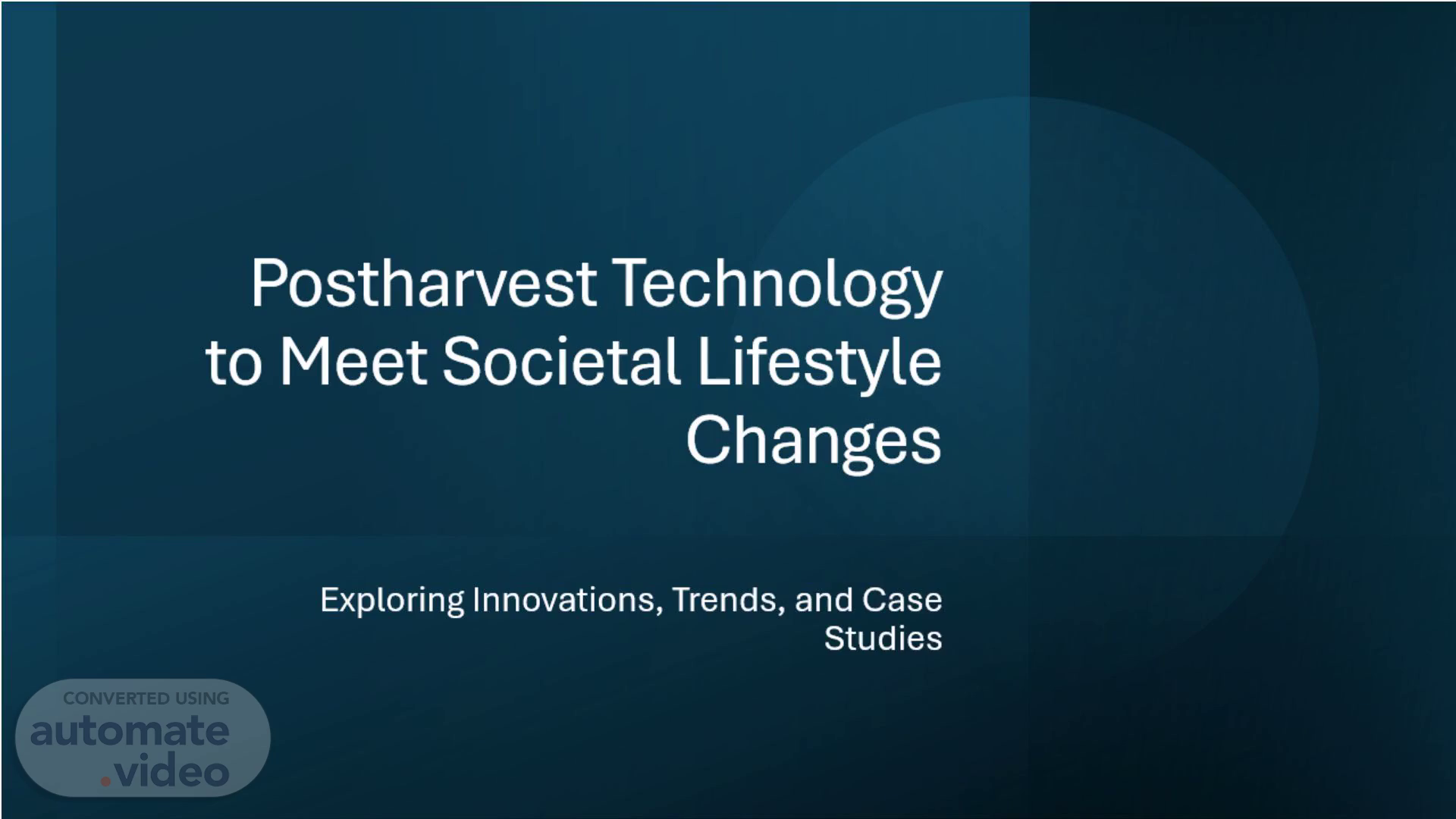
Postharvest Technology to Meet Societal Lifestyle Changes
Scene 1 (0s)
[Audio] "Welcome to today's lecture on Postharvest Technology and its role in addressing changes in societal lifestyles. In this session, we will explore key innovations in postharvest management, advancements in storage, packaging, and sustainability, and the role of government policies in ensuring food security. Let's begin with an introduction to postharvest technology.".
Scene 2 (23s)
[Audio] Postharvest technology plays a crucial role in maintaining food quality, reducing waste, and ensuring food security worldwide. With rapid urbanisation, changing dietary habits, and growing demand for convenience foods, it has become essential to develop innovative postharvest solutions. This lecture will focus on how societal lifestyle changes influence food consumption patterns and the technological advancements that help address these evolving needs.
Scene 3 (54s)
[Audio] Postharvest technology refers to the processes and innovations applied to agricultural products after harvest to maintain quality, extend shelf life, and reduce losses. Key components include handling, storage, processing, packaging, and transportation. These technologies ensure that food remains safe and nutritious from farm to consumer, playing a critical role in food security and economic stability.
Scene 4 (1m 23s)
[Audio] Modern consumers are increasingly looking for convenience, healthier options, and sustainability in their food choices. Urbanisation has led to busy lifestyles, increasing demand for ready-to-eat and minimally processed foods. There is also a growing awareness of nutrition, leading to higher demand for organic and functional foods. Moreover, the expansion of online grocery shopping has changed supply chain dynamics, requiring better postharvest management to maintain food freshness during transit.".
Scene 5 (1m 57s)
[Audio] These lifestyle changes directly affect food demand. Consumers now prefer organic, minimally processed, and long-shelf-life products. Additionally, globalisation has increased the demand for exotic and out-of-season foods, which require advanced postharvest handling to maintain quality. At the same time, sustainable packaging solutions are needed to reduce environmental impact while ensuring food safety.
Scene 6 (2m 25s)
[Audio] Packaging plays a crucial role in extending shelf life and maintaining food quality. Innovations such as Modified Atmosphere Packaging (MAP), edible coatings, and biodegradable materials help reduce food spoilage and waste. Smart packaging solutions, equipped with sensors to monitor freshness, are also gaining traction. A key example is avocado ripening control packaging, which helps slow down ripening during transport, reducing losses..
Scene 7 (2m 56s)
[Audio] Storage innovations are critical in postharvest technology. Controlled Atmosphere Storage (CAS) helps maintain the right gas composition to prolong freshness. Cold chain logistics ensure temperature-controlled storage from harvest to retail. Additionally, smart sensors now allow real-time monitoring of storage conditions, improving food safety and reducing waste. In India, cold storage solutions have significantly reduced banana losses, benefiting farmers and the economy..
Scene 8 (3m 29s)
[Audio] Processing methods have evolved to preserve food quality while minimising nutrient loss. Minimally processed foods, High-Pressure Processing (HPP), and the use of UV and ozone treatments are some of the latest advancements. These techniques help extend shelf life while maintaining food safety. For example, fresh-cut salad packaging using modified environments has significantly increased shelf life, reducing food waste in retail markets..
Scene 9 (4m 0s)
[Audio] Efficient transportation is essential in reducing postharvest losses. Refrigerated transport, blockchain technology for traceability, and AI-driven logistics are transforming the way food is delivered. For instance, Norway has successfully implemented blockchain-based seafood supply chain tracking, ensuring transparency and reducing losses in perishable seafood exports..
Scene 10 (4m 25s)
[Audio] Food waste remains a major challenge worldwide. Postharvest losses contribute significantly to this issue. Advanced sorting and grading technologies, coupled with AI and automation, can help identify defects early and improve food quality control. AI-powered sorting in apple production has led to better quality control, reducing the percentage of rejected apples and minimising waste.
Scene 11 (4m 52s)
[Audio] Climate variability poses new challenges to food supply chains. Rising temperatures and unpredictable weather patterns impact storage conditions and transportation efficiency. Innovations in heat-resistant packaging and solar-powered cold storage solutions are crucial in mitigating these challenges. In Africa, solar-powered cold storage has improved food preservation, particularly in regions lacking electricity access.
Scene 12 (5m 21s)
[Audio] Sustainability is now a priority in postharvest technology. Reducing the carbon footprint in food logistics, adopting circular economy approaches, and using sustainable processing techniques are key solutions. A notable case study is the reuse of agricultural by-products in food packaging, such as using banana fibre in biodegradable packaging solutions..
Scene 13 (5m 45s)
[Audio] Consumer education plays a significant role in reducing food waste and promoting sustainability. Labelling and certification help consumers make informed choices. Technology-driven food safety measures, such as QR codes on packaging, provide transparency in farm-to-table tracking, allowing consumers to verify the origins and freshness of their food..
Scene 14 (6m 10s)
[Audio] Government policies play a crucial role in shaping postharvest practices. Global food safety standards, trade policies, and government initiatives to reduce postharvest losses influence industry standards. The FAO has been instrumental in advancing postharvest technologies, providing guidelines for sustainable food management worldwide..
Scene 15 (6m 34s)
[Audio] The future of postharvest technology lies in automation and AI. AI and IoT (Internet of Things) are increasingly being used for real-time quality control. Additionally, 3D printing of food and packaging materials is being explored as a sustainable innovation. Future advancements in postharvest biotechnology will continue to address food security and efficiency challenges..
Scene 16 (7m 2s)
[Audio] In summary, postharvest technology is essential for meeting the changing demands of modern consumers. As lifestyles evolve, innovative storage, packaging, processing, and transportation technologies are needed to ensure food security and sustainability. Looking ahead, continued research and development in postharvest technology will be crucial in addressing global food challenges. Thank you for your attention!.